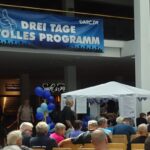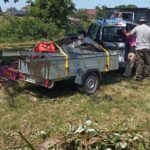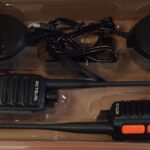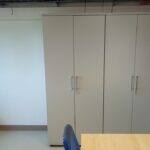


HowTo (how i did it, YMMV)
Reflector: Cut a sheet of copper (0.5mm thick) about 103 by 103mm using guillotine shears (Schlagschere). Use a scriber (Anreißnadel) and ruler (Lineal) to scratch a line from adjacent corners so the crossing lines mark the center of the square sheet (you learned that in school, didn’t you). Use a divider (Stechzirkel, Anreißzirkel) to draw a circle 101.6mm dia. around the center. Now, where a scratched line crosses the circle , measure 37.30mm to mark the position for the hole to be drilled . Check from the adjacent side if the distance is 101.60mm-37.30mm=64.30mm. Now cut off the excess copper using the guillotine shears slowly making the sheet round cut by cut . You now have an imperfectly round reflector, but it is important to have the exact position and distance from the center for the hole to be drilled.
Patch: Cut the patch 58*58mm using the guillotine shears, use the scriber to scratch crossing lines from adjacent corners. You have the exact center of the patch. Mark 29mm on the upper and lower edge, then scratch a line from one mark to the other. It should pass the center exactly. Now mark the line 42.5mm distance from the lower edge. This is the position for the hole. The diameter for the hole depends on the type of socket you use and the dia. of the pin. The original description says 3.17mm (which i believe was converted from inches to mm). I had to drill 4mm in the reflector and abt. 1.5mm in the patch. Now mark and cut off the upper left and lower right corners. Glue 2 Spacers of non-conductive material, 3mm thick, to the patch. Solder the socket to the back of the reflector. Solder the patch to the pin of the socket. Do not glue the spacers to the reflector, in order to still be able to rotate the patch for a good match. Once the match is found, use superglue to fix the spacers on the reflector. UPDATE: The superglue didn’t stick good on the reflector, the patch could be moved. So DJ8LC aligned the antenna again, leaving the spacers in their places and drilled 2.1mm holes all the way through the patch, spacers and reflector. Next we inserted 2mm nylon screws in each hole and melted their shafts flat on the back of the reflector. A new measurement revealed an even better return loss.
73, DM4iM
P.S. This is my first experience with frequencies above 430Mhz. Looking at my qrz.com picture you might think I’m an expert for this, but i was only maintaining the rotator for the dish @dl0wh, so the microwave stuff you see there is not mine (i did the climbing for most of the stuff, though).
So the credits go to Michael DL7UKM, for discussing a lot on the local VHF-channel, and most of all to Wolfgang DJ8LC for measurement and alignment AND his superb modification to the LNB which is very stable while others say they modified the same LNB , but no joy. If you need more info, drop me a few lines callsign at t minus online de.




